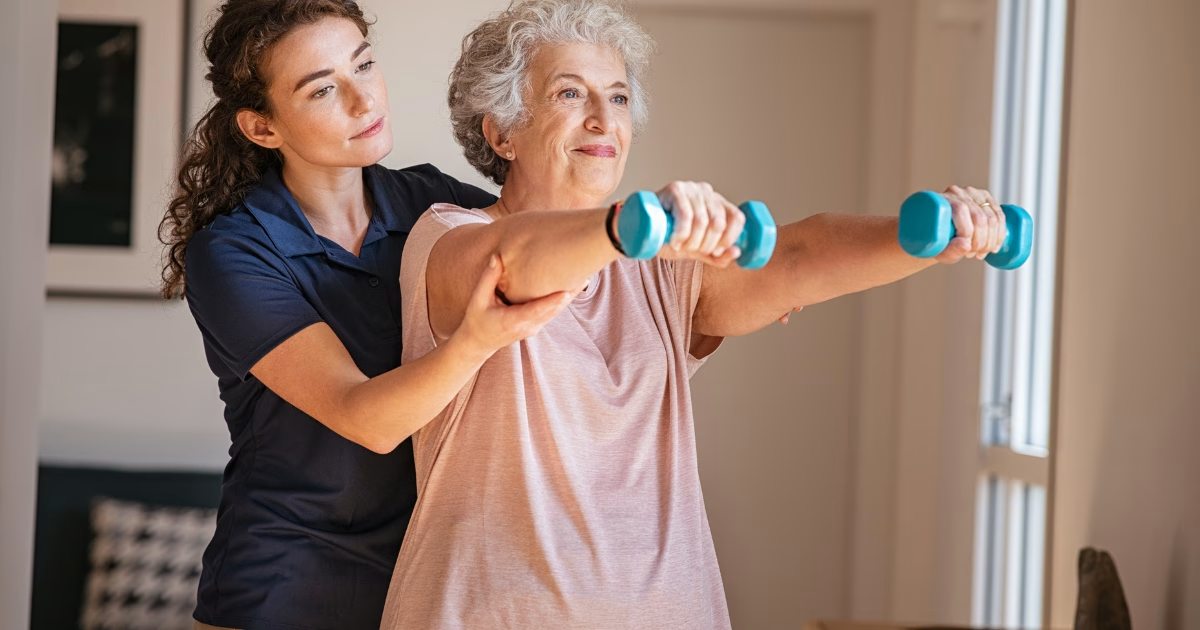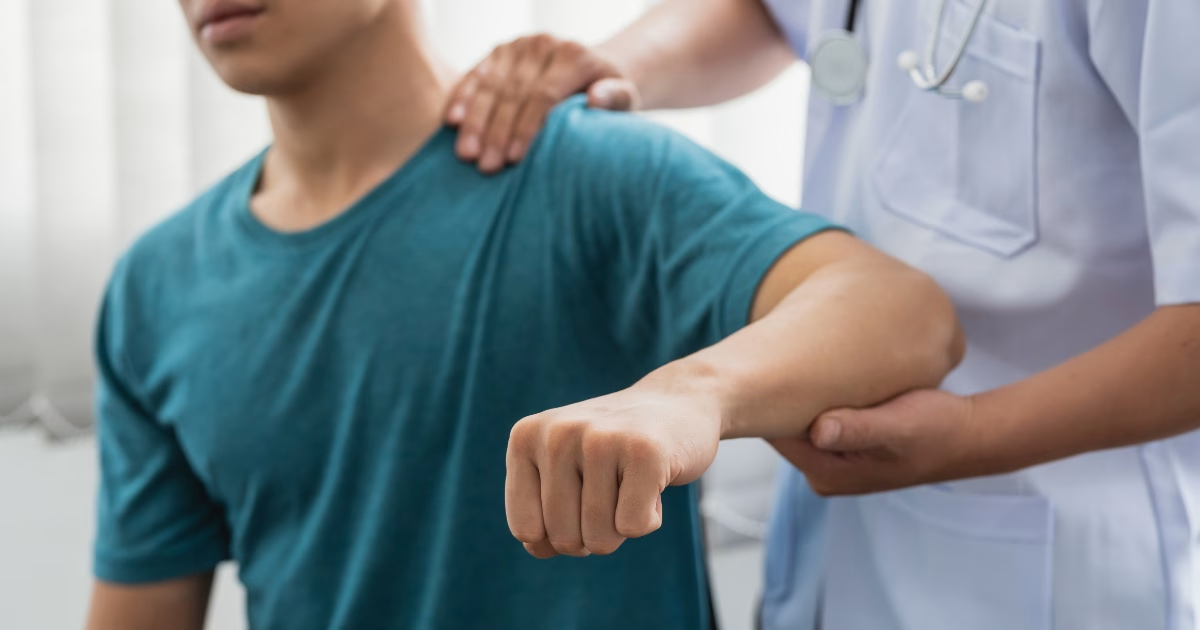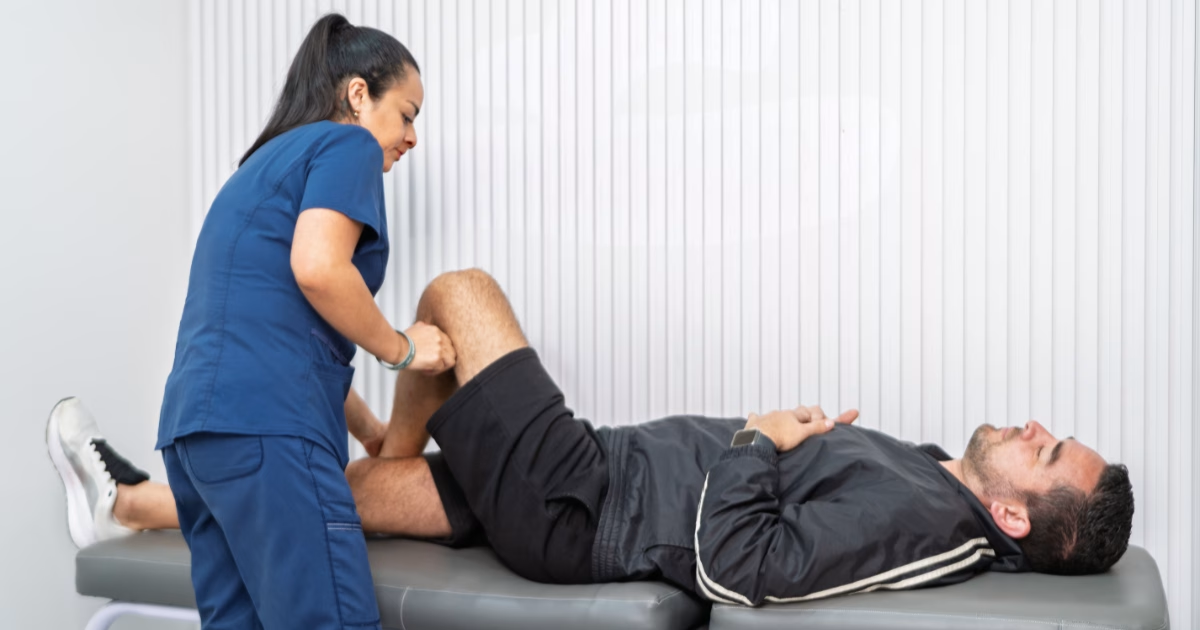Sports injury physiotherapy at Movewell focuses on athlete recovery and rehabilitation, ensuring a path to optimal health. Our online physio clinic offers tailored exercise therapy and movement analysis to enhance performance and prevent future sports injuries.
What is Sports Injury Physiotherapy?
Sports injury physiotherapy is a special kind of physical therapy. It’s all about helping people who get hurt while playing sports or exercising. The main goals are to prevent injuries, figure out what’s wrong, treat those injuries, and help people recover. This type of physiotherapy uses different methods to help athletes get back to their game and do it safely.
Here are some key points about sports injury physiotherapy:
- Injury Diagnosis: Figuring out what type of injury you have is really important. It helps in choosing the right treatment.
- Personalized Treatment Plans: Every athlete gets a plan that suits their specific needs and goals.
- Rehabilitation Techniques: This includes hands-on therapy, exercises to improve strength, and methods like ultrasound or electrical stimulation.
By addressing both physical issues and problems that come from playing sports, this kind of physiotherapy is key in helping athletes return to their sport without getting hurt again.
Benefits of Sports Injury Physiotherapy
Going for sports injury physiotherapy has many benefits. These can make a big difference in how fast someone heals and how well they perform in their sport. Some major benefits are:
- Accelerated Injury Recovery: The treatments help healing happen quicker by increasing blood flow and helping tissue repair.
- Pain Management: There are effective ways to relieve pain for both new injuries like sprains and ongoing issues like tendonitis.
- Improved Range of Motion & Flexibility: Special stretching exercises help improve flexibility, which is super important for moving well in any sport.
With these focused treatments, athletes can feel ready for their activities while lowering the chance of getting hurt again.
Common Sports Injuries
Sports injuries are a big deal for athletes at all levels. They can mess with performance and everyday life. Knowing about these injuries helps in both preventing them and managing them better.
Types and Causes of Acute and Chronic Sports Injuries
Acute sports injuries happen suddenly while playing. They often result from trauma or overdoing it. Some common examples include sprains, fractures, and strains. Here are some causes:
- High-impact collisions: This often occurs in contact sports like football or hockey.
- Falls: These are common in activities like gymnastics or skiing.
- Improper technique: This can lead to muscle strains or ligament tears.
On the other hand, chronic sports injuries build up over time. They are usually caused by repeated stress on muscles, tendons, or joints. For example, runners often face conditions like Achilles tendonitis due to:
- Overtraining: Pushing the body too hard without enough rest can be harmful.
- Poor biomechanics: Bad movement patterns increase the risk of injury.
Effective physiotherapy for lower limb injuries offers personalized strategies for recovery. Upper limb injury rehabilitation specifically addresses problems related to the shoulder, elbow, or wrist.
Impact on Athletic Performance and Daily Life
Injuries can really hurt athletic training by reducing strength and mobility. Athletes may find it hard to perform their best due to pain or limited movement. Recovery times can vary based on how bad the injury is but generally involve resting first, then slowly returning to sport-specific activities. This recovery is essential for getting back safely and avoiding more injuries in the future.
Physiotherapy Treatment for Sports Injuries
Physiotherapy is key in treating sports injuries. It uses various methods to help restore function and reduce pain.
Assessment and Diagnosis
A good assessment is necessary to understand an athlete’s injury fully. Some key techniques include:
- Sports Injury Assessment: This looks at symptoms through physical exams.
- Functional Movement Assessment: This checks how movements affect overall function, helping to identify issues causing the injury.
Having an accurate diagnosis helps make better treatment decisions tailored to each athlete’s needs.
Personalized Treatment Plans
Bespoke treatment plans are vital for addressing different types of sports injuries. These plans often mix various therapies based on what was found during assessments.
Manual Therapy Techniques
Manual therapy techniques are commonly used in physiotherapy. These include:
- Massage therapy: It helps ease muscle tension and boosts blood flow.
- Joint mobilization: This improves joint movement which speeds up recovery.
These hands-on methods support healing after an injury effectively.
Exercise Therapy
Exercise therapy covers many rehabilitation exercises that aim to strengthen weak areas and improve flexibility through specific stretching routines designed for athletes recovering from injuries:
- Strengthening exercises target muscles affected by the injury.
- Stretching routines keep flexibility throughout recovery, ensuring the best range of motion is restored promptly after healing begins.
This way, athletes can regain their performance levels without risking further problems during recovery.
Modalities
Modalities like ultrasound therapy play a significant role in rehab programs focused on pain management related to acute or chronic cases. Modern technology paired with traditional methods offers a range of options for treating sports injuries effectively today!
Movewell’s Approach to Sports Injury Rehabilitation
At Movewell, we know that sports injuries can be tough. Our approach to sports injury rehabilitation focuses on the individual needs of each athlete. We start with personalized assessments that look at how the body moves and how it works. By doing functional movement assessments and biomechanical analysis, we can create bespoke treatment plans that fit your specific needs. Our goal is to ensure that recovery plans are based on the latest research in physical therapy for sports injuries.
Key Features of Our Approach:
- Bespoke Treatment Plans: Each plan is made just for you, considering your injury type and goals.
- Evidence-Based Practices: We use techniques backed by research to improve recovery outcomes.
- Online Physiotherapy Options: Enjoy virtual physiotherapy sessions without sacrificing quality care.
Rehabilitation Phases
Recovering from a sports injury usually goes through three main phases. Each phase has its own focus to help you heal better.
Acute Stage: Rest and Inflammation Management
After an injury, the first step is to handle pain and swelling. During this time, resting is key. We might use manual therapy techniques to help ease discomfort. Other tools like electrical stimulation can also support tissue healing. Athletes may need gentle movements when they’re ready, but rest is important.
Subacute Stage: Gradual Movement and Strength Recovery
Once you move past the acute stage, it’s time to get back moving. In this subacute phase, we work on restoring your range of motion while slowly increasing strength. This includes rehabilitation exercises designed just for you. They help make sure you’re safe as you get back into action. Working under professional guidance helps build your confidence during recovery.
Chronic Stage: Functional Restoration and Performance Enhancement
In the final stage of rehabilitation, we shift our focus to getting you back into sport-specific activities. This means functional restoration that prepares athletes for what’s next. Strategies here include advanced strengthening programs that build muscle and enhance performance longevity with proprioceptive training methods. These tools ensure that athletes return to their sport stronger and more prepared.
By following these clear phases in our approach at Movewell, we aim for more than just recovery; we want every athlete to feel empowered and ready for long-term success in their sport.
Advanced Techniques and Modalities
In sports injury physiotherapy, advanced techniques and modalities are key for recovery. These methods help athletes heal and return to peak performance. Here are some important approaches in modern physiotherapy.
Dry Needling
Dry needling is a cool technique for pain management and muscle strain recovery. It involves using thin needles on specific muscle points to reduce tension and pain. This method helps increase blood flow to injured areas, which speeds up healing. Many athletes use dry needling as part of their injury recovery strategies so they can get back to their activities faster.
Myofascial Release
Myofascial release uses manual therapy to treat musculoskeletal injuries through soft tissue mobilization. This approach focuses on the fascia, the connective tissue that surrounds muscles. By applying gentle pressure, therapists can relieve tightness and improve mobility. This method enhances comfort and function during physical activities.
Electrical Stimulation
Electrical stimulation is an advanced method used in physical rehabilitation, especially for treating acute injuries. This technique sends electrical impulses to nerves or muscles, promoting healing while reducing pain during rehabilitation exercises. It also aids muscle re-education after injuries and helps maintain strength when movement is limited.
Kinesiology Taping
Kinesiology taping has become popular among athletes for support during training or competitions. This method involves placing elastic tape on joints or muscles to provide support without restricting movement. It helps with joint mobilization techniques essential for assessing functional movement. The tape also prevents further injuries and boosts awareness of body position, improving athletic performance.
Benefits of Specialist Modalities
Using specialized modalities provides several benefits that lead to better outcomes in sports injury physiotherapy.
Targeted Pain Relief
One main benefit of these specialist modalities is targeted pain relief. They focus on chronic injury management at sports injury clinics through orthopedic physiotherapy practices tailored to individual needs. Techniques like dry needling and myofascial release effectively address localized discomfort, helping patients regain functionality quickly.
Improved Muscle Function and Flexibility
These advanced techniques can also improve muscle function and flexibility. Stretching and strengthening exercises are important parts of any athlete’s routine, prescribed by professionals. Enhanced flexibility not only boosts performance but also lowers the risk of future injuries with exercise plans suited to each athlete’s needs.
Reduced Recovery Time
One major advantage of using these specialized modalities is reduced recovery time after injuries—very important for today’s athletes. Options like online treatment platforms make it easier than ever to access care remotely through virtual physiotherapy consultations, allowing for continuous support throughout rehab phases until full recovery is achieved!
Why Athletes Need Sports Physiotherapy
Athletes often face injuries because their sports are physically demanding. Sports injury physiotherapy is key for treating these injuries and preventing new ones. Regular check-ups with a physiotherapist help athletes spot risks early and work on ways to avoid them.
Importance of Injury Prevention
Injury prevention is super important for athletes who want to have long careers. A solid exercise program that builds strength can make a big difference in avoiding injuries. When athletes act fast on any problems, they can heal quicker and get back to playing sooner, which helps keep their performance strong.
Benefits of Sports Injury Physiotherapy
- Personalized Treatment Plans: Every athlete has different needs based on their sport and how their body works. Creating specific treatment plans that take these differences into account makes recovery more effective.
- Faster Recovery: Physiotherapists use techniques like manual therapy, stretching, and machines like ultrasound to help healing happen faster.
- Education and Awareness: By learning about the right ways to move and take care of their bodies, athletes can avoid getting hurt again.
Choosing the Right Sports Physiotherapist
Picking the right sports physiotherapist is important for getting the best care. When looking for someone to help, consider a few key points.
Key Considerations:
- Qualifications and Experience: Find therapists with special training in sports medicine or related areas.
- Bespoke Treatment Plans: Check if they provide personalized care that fits your unique needs instead of a one-size-fits-all approach.
- Comprehensive Assessments: A good therapist will do detailed checks that include functional movement analysis to find what needs fixing.
- Innovative Techniques: See if they use modern methods like dry needling or kinesiology taping relevant to your issue.
- Accessibility Options: With busy schedules, online physiotherapy services can offer support during recovery without losing quality care.
By carefully selecting a sports physiotherapist, athletes boost their chances for successful rehab while enjoying long-term health benefits through smart management strategies offered by experienced professionals.
Success Stories and Testimonials
Case Studies of Successful Athlete Recovery
At Movewell, we take pride in our sports injury rehabilitation programs. We create programs for each athlete based on their needs. Here are some case studies showing how our bespoke treatment plans helped athletes recover.
- Athlete A: After a knee injury in basketball, Athlete A got a complete injury diagnosis and personalized physical rehabilitation at Movewell. In just weeks, they noticed improved mobility. They returned to play with even more strength.
- Athlete B: Following an ankle sprain during soccer practice, this athlete used our sports injuries prevention strategies along with physiotherapist consultations. Targeted exercises and education on proper techniques helped them avoid future injuries.
These success stories show that personalized care can lead to amazing recoveries for athletes in various sports.
Patient Testimonials and Feedback
Patient feedback is important for us to understand how our services help. Here are some testimonials from people who benefited from online physiotherapy sessions:
- “The virtual physiotherapy sessions were super convenient! I got expert advice without leaving my home.” – Patient X
- “My consultation with the physiotherapist was thorough. I felt supported throughout my recovery.” – Patient Y
These testimonials highlight the effectiveness of both in-person and online options available at Movewell for patient support.
Latest Research and Advancements
Staying updated with the latest research in sports injury physiotherapy helps us provide evidence-based care that improves recovery results.
Updates on Research and Developments in Sports Injury Physiotherapy
Recent orthopedic physiotherapy research findings show important advancements in chronic injury management studies. These include:
- Better diagnostic tools that help identify underlying issues accurately.
- New therapeutic techniques to improve healing times while reducing pain.
- Evidence that supports combining physical therapy with other treatments for better results.
These insights allow us to constantly improve our practices so we can provide top-notch care tailored to individual needs.
Movewell’s Commitment to Evidence-Based Care
At Movewell, we focus on using evidence-based practices in sports physio that match current scientific findings. Our commitment includes applying performance enhancement techniques backed by recent studies that prove they are effective for treating specific athletic injuries.
By using these advancements in our treatment methods, we aim not only for successful recoveries but also for long-term health benefits for all athletes we support.






